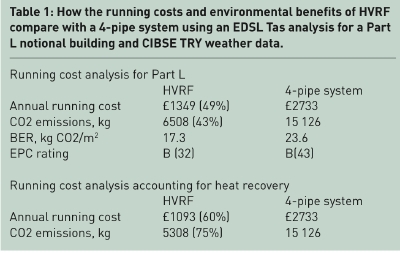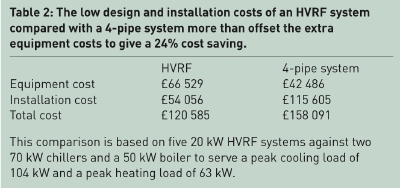VRF meets chilled water

VRF air-conditioning systems and 4-pipe systems both have their pros and cons. Now Mitsubishi Electric reckons it has developed a system with more of the pros and fewer of the cons — and with added benefits. Ken Sharpe explains.
Five years ago, the air-conditioning division of Mitsubishi Electric in the UK embarked on a secret project at its Hatfield headquarters to develop an approach to air conditioning combining the benefits of heat-recovery-VRF and chilled-water systems served by chiller and boiler plant.
The outcome has been dubbed HVRF (hybrid VRF), and a manufactured, rather than prototype version, has now been installed in the refurbished premises of M&E specialist Working Environments at Southampton. That first installation in the world marks the beginning of general market availability.
A key point, however, is that the concept is based on the use of Mitsubishi fan-coil units so that the control functionality of a VRF system can be achieved.
Mark Grayston, air-conditioning product manager with Mitsubishi, explains that there were a number of key drivers for the development of HVRF. One was the target to reduce the UK’s CO2 emissions by 80% by 2050 compared to 1990 levels. Another was to ensure energy supply meets demand. As will be explained later, the CO2 emissions of an HVRF system are 75% lower than those from a 4-pipe fan-coil system.
Turning to operating costs, the annual energy bill for an HVRF system is only 40% that of a 4-pipe fan-coil system served by a chiller/boiler combination. Heat recovery and heating provided by reverse-cycle operation are among the reasons for the lower bill.
And for those of you who might not be swayed by longer-term savings, the design and installation costs of an HVRF system are 24% lower than a 4-pipe system.
Using water as the energy carrier in the conditioned space has significant advantages over refrigerants such as R410A now generally used in VRF systems. The key benefit is comfort, with fan-coil units being ‘gentler’ in the way they provide environmental comfort compared to DX units. Another benefit is keeping refrigerant out of occupied spaces, thereby avoiding the need for leak detection — especially in hotel bedrooms.
What 4-pipe fan-coil systems cannot do is to recover energy from parts of the building being cooled and use it to heat other parts. That capability of heat-recovery VRF is offered by Mitsubishi’s HVRF system by the design of the HBC box, the function of which corresponds to the BC box in a Mitsubishi VRF system — and which has the same depth. HVRF and VRF systems both offer simultaneous heating and cooling via a 2-pipe system.
If an HBC box is required to deliver both heating and cooling to the FCUs it serves, the outdoor unit delivers a mixture of liquid and hot gaseous refrigerant to it. This mixture first passes through a plate heat exchanger to heat water by condensing the gaseous refrigerant. Liquid refrigerant then passes to a second plate heat exchanger to provide cooling.
The present design of HBC box, which would typically be installed in a ceiling void, has eight pairs of flow and return connections to fan-coil units. Each circuit can independently deliver heated or chilled water via an arrangement of 3-port valves to connect to one or other of the plate heat exchangers using a speed-controlled pump in the HBC box. A valve on each circuit controls flow rate. Chilled-water temperature can typically vary from 7 to 10°C, controlled to a ∆T of 5 K between flow and return. Future plans include the development of an HBC box to serve 16 FCUs.

Alex Bagnall, HVRF product manager, sees two main application areas for HVRF.
• High-end office, but VRF will be cheaper for most offices.
• Hotels, which will benefit from milder off-coil temperatures and there being no requirement for refrigerant detection in bedrooms.
The installation for Working Environments referred to earlier was part of the development and modernisation of its existing headquarters at Monza House in Southampton to accommodate the integration of three company locations on the south coast.
The new facilities comprise a new office area seating 58 engineering and surveying staff, eight meeting rooms, an IT training suite and a staff breakout area. A new plant room, print room and 80-set auditorium were created.
The facility is served by a single air-handling unit providing fresh air. There are also two City Multi VRF systems with both ducted and ceiling cassettes.
It is the modernisation of offices on the first floor where the HVRF air conditioning was installed.
Mike Jenkins, special projects director for Working Environments, explains, ‘We have installed monitoring equipment to allow us to see how well the system is working for us, and the feedback from staff has been fantastic. Everyone has noticed how much fresher and more balanced the internal temperatures have been, and we’ve also notice fewer draughts.’
Mitsubishi’s Mark Grayston concludes, HVRF now offers a serious alternative to chiller technology and allows even more building owners to benefit from the low-carbon potential of heat pumps.









